Lesson One Legal System 法律制度
- 格式:docx
- 大小:24.09 KB
- 文档页数:3
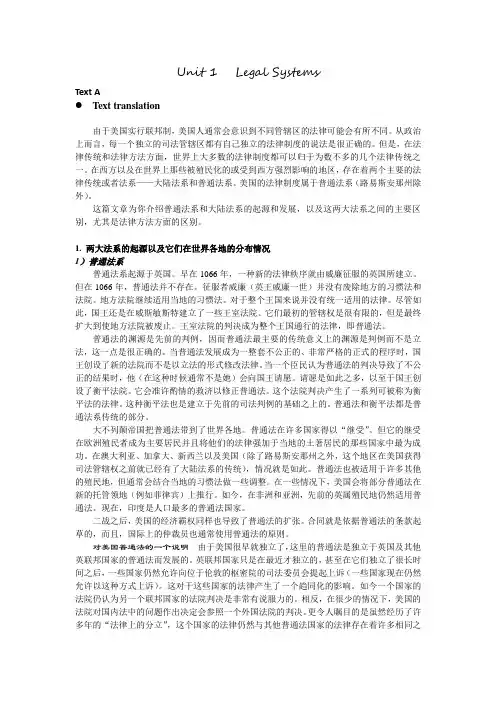
Unit 1 Legal SystemsText AText translation由于美国实行联邦制,美国人通常会意识到不同管辖区的法律可能会有所不同。
从政治上而言,每一个独立的司法管辖区都有自己独立的法律制度的说法是很正确的。
但是,在法律传统和法律方法方面,世界上大多数的法律制度都可以归于为数不多的几个法律传统之一。
在西方以及在世界上那些被殖民化的或受到西方强烈影响的地区,存在着两个主要的法律传统或者法系——大陆法系和普通法系。
美国的法律制度属于普通法系(路易斯安那州除外)。
这篇文章为你介绍普通法系和大陆法系的起源和发展,以及这两大法系之间的主要区别,尤其是法律方法方面的区别。
1. 两大法系的起源以及它们在世界各地的分布情况1)普通法系普通法系起源于英国。
早在1066年,一种新的法律秩序就由威廉征服的英国所建立。
但在1066年,普通法并不存在。
征服者威廉(英王威廉一世)并没有废除地方的习惯法和法院。
地方法院继续适用当地的习惯法。
对于整个王国来说并没有统一适用的法律。
尽管如此,国王还是在威斯敏斯特建立了一些王室法院。
它们最初的管辖权是很有限的,但是最终扩大到使地方法院被废止。
王室法院的判决成为整个王国通行的法律,即普通法。
普通法的渊源是先前的判例,因而普通法最主要的传统意义上的渊源是判例而不是立法,这一点是很正确的。
当普通法发展成为一整套不公正的、非常严格的正式的程序时,国王创设了新的法院而不是以立法的形式修改法律。
当一个臣民认为普通法的判决导致了不公正的结果时,他(在这种时候通常不是她)会向国王请愿。
请愿是如此之多,以至于国王创设了衡平法院。
它会准许酌情的救济以修正普通法。
这个法院判决产生了一系列可被称为衡平法的法律。
这种衡平法也是建立于先前的司法判例的基础之上的。
普通法和衡平法都是普通法系传统的部分。
大不列颠帝国把普通法带到了世界各地。
普通法在许多国家得以“继受”。
但它的继受在欧洲殖民者成为主要居民并且将他们的法律强加于当地的土著居民的那些国家中最为成功。
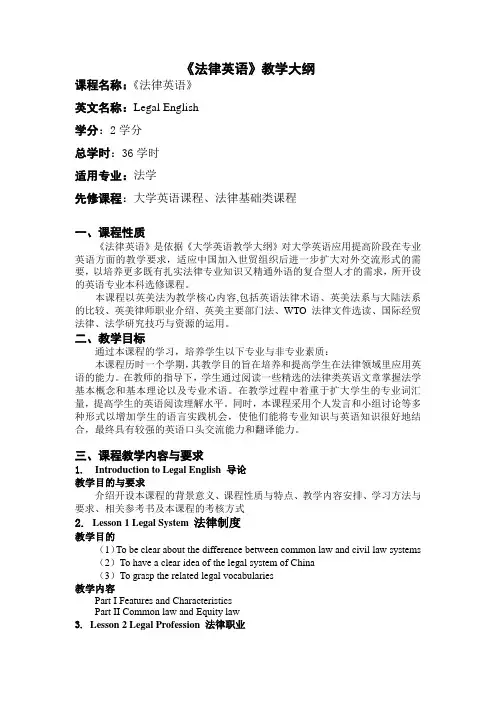
《法律英语》教学大纲课程名称:《法律英语》英文名称:Legal English学分:2学分总学时:36学时适用专业:法学先修课程:大学英语课程、法律基础类课程一、课程性质《法律英语》是依据《大学英语教学大纲》对大学英语应用提高阶段在专业英语方面的教学要求,适应中国加入世贸组织后进一步扩大对外交流形式的需要,以培养更多既有扎实法律专业知识又精通外语的复合型人才的需求,所开设的英语专业本科选修课程。
本课程以英美法为教学核心内容,包括英语法律术语、英美法系与大陆法系的比较、英美律师职业介绍、英美主要部门法、WTO 法律文件选读、国际经贸法律、法学研究技巧与资源的运用。
二、教学目标通过本课程的学习,培养学生以下专业与非专业素质:本课程历时一个学期,其教学目的旨在培养和提高学生在法律领域里应用英语的能力。
在教师的指导下,学生通过阅读一些精选的法律类英语文章掌握法学基本概念和基本理论以及专业术语。
在教学过程中着重于扩大学生的专业词汇量,提高学生的英语阅读理解水平。
同时,本课程采用个人发言和小组讨论等多种形式以增加学生的语言实践机会,使他们能将专业知识与英语知识很好地结合,最终具有较强的英语口头交流能力和翻译能力。
三、课程教学内容与要求1. Introduction to Legal English导论教学目的与要求介绍开设本课程的背景意义、课程性质与特点、教学内容安排、学习方法与要求、相关参考书及本课程的考核方式2. Lesson 1 Legal System 法律制度教学目的(1)To be clear about the difference between common law and civil law systems (2)To have a clear idea of the legal system of China(3)To grasp the related legal vocabularies教学内容Part I Features and CharacteristicsPart II Common law and Equity law3. Lesson 2 Legal Profession法律职业教学目的(1)To be clear about the American legal profession(2)To learn certain legal phrases, such as practicing lawyer, legal instruments, associates, practice preventive law(3)To understand the process of engaging a lawyer(4)To get acquainted with some useful expressions in engaging a lawyer教学内容Part I The BarPart II Lawyers in Private PracticePart III House CounselPart IV Lawyers in Government4. Lesson 3 Legal Education法律教育教学目的(1)To be clear about the curriculum of American legal education(2)To distinguish the case method from lecture method(3)To learn some legal phrases: Regulatory state; clinical education; layering; law faculties; in high-prestige fields of law教学内容Part I Curriculum and the case methodPart II Law school hierarchy5. Lesson 4 Judicial System 司法体系教学目的(1)To be clear about the American court system and English court system(2)To distinguish between trial courts and appellate courts(3)To be clear about the position of the Judges in court(4)To learn certain legal vocabulary, such as jurisdiction, sue, plaintiff, defendant, action, petition, and so on教学内容Part I CourtsPart II Judges6. Lesson 5 Constitution宪法教学目的(1)To be clear about the feature of the US Constitution, the fundamental principles of government and the provisions for amendment(2)To learn legal phrase: Judicial interpretation; national convention; implement; check and balance; separation of powers; federalism教学内容Part I The constitution as the supreme lawPart II The principles of governmentPart III Provisions for amendment7. Lesson 6 Administrative Law行政法教学目的(1)To be clear about the scope of the administrative law(2)To know the definition of “agency” in the Federal Administrative Procedure (3)To be clear about the functions of regulatory agencies and non-regulatory agencies教学目的(1)To know the background of the US property law(2)To be clear about fundamentals of real property law(3)To understand the role of the lawyer in real property transactions(4)To learn legal phrases: Due diligence; formalities; instruments; secondary party; easement; security devices; mortgage holder; recovery of possession教学内容Part I IntroductionPart II The fundamentals of real property lawPart III The role of the lawyer in real property transactions六、实验、实训等实践教学要求1. Topic discussion实践项目:to discuss 2 topics1)Do you want to be a judge or a lawyer?2)Discussion of the principle of checks and balances实践目的:to use legal terms to state one’s views on the above topics in English2. Listening practice实践项目:to listen to the text and repeat or dictate while learning each lesson实践目的:to make an understanding of the legal paras and civil and criminal procedures3. Translation practice实践项目:to translate the constitution of the US实践目的:to know the constitution of the US and to learn some translation skills 4. Case analysis实践项目:to read one case实践目的:to know the way to read real cases and its decisions5. Mock trial实践项目:Williams v.Walker-Thomas Furniture Co.实践目的:to know the tasks and skills of acting as different roles in an appeal case 七、思考题、三习题法律英语课程的思考题及三习题的设置必须覆盖教学的核心内容、重点、难点,学生“三习”的时间与教学时间之比不少于1:1。
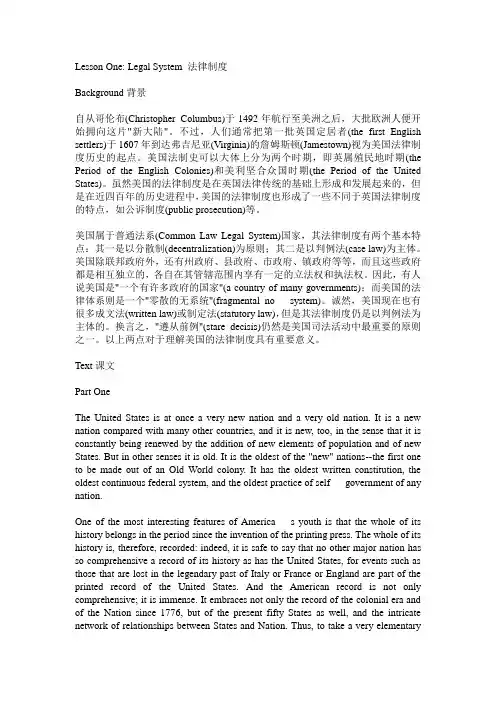
Lesson One: Legal System 法律制度Background背景自从哥伦布(Christopher Columbus)于1492年航行至美洲之后,大批欧洲人便开始拥向这片"新大陆"。
不过,人们通常把第一批英国定居者(the first English settlers)于1607年到达弗吉尼亚(Virginia)的詹姆斯顿(Jamestown)视为美国法律制度历史的起点。
美国法制史可以大体上分为两个时期,即英属殖民地时期(the Period of the English Colonies)和美利坚合众国时期(the Period of the United States)。
虽然美国的法律制度是在英国法律传统的基础上形成和发展起来的,但是在近四百年的历史进程中,美国的法律制度也形成了一些不同于英国法律制度的特点,如公诉制度(public prosecution)等。
美国属于普通法系(Common Law Legal System)国家,其法律制度有两个基本特点:其一是以分散制(decentralization)为原则;其二是以判例法(case law)为主体。
美国除联邦政府外,还有州政府、县政府、市政府、镇政府等等,而且这些政府都是相互独立的,各自在其管辖范围内享有一定的立法权和执法权。
因此,有人说美国是"一个有许多政府的国家"(a country of many governments);而美国的法律体系则是一个"零散的无系统"(fragmental no system)。
诚然,美国现在也有很多成文法(written law)或制定法(statutory law),但是其法律制度仍是以判例法为主体的。
换言之,"遵从前例"(stare decisis)仍然是美国司法活动中最重要的原则之一。
以上两点对于理解美国的法律制度具有重要意义。
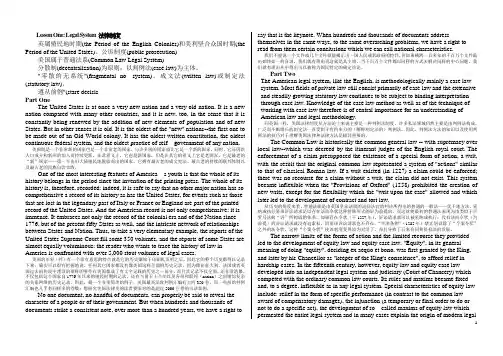
Lesson One: Legal System 法律制度英属殖民地时期(the Period of the English Colonies)和美利坚合众国时期(the Period of the United States)。
公诉制度(public prosecution)美国属于普通法系(Common Law Legal System)分散制(decentralization)为原则;以判例法(case law)为主体。
"零散的无系统"(fragmental no system)。
成文法(written law)或制定法(statutory law),遵从前例"(stare decisisPart OneThe United States is at once a very new nation and a very old nation. It is a new nation compared with many other countries, and it is new, too, in the sense that it is constantly being renewed by the addition of new elements of population and of new States. But in other senses it is old. It is the oldest of the "new" nations--the first one to be made out of an Old World colony. It has the oldest written constitution, the oldest continuous federal system, and the oldest practice of self government of any nation.美国既是一个非常新的国家也是一个非常老的国家。
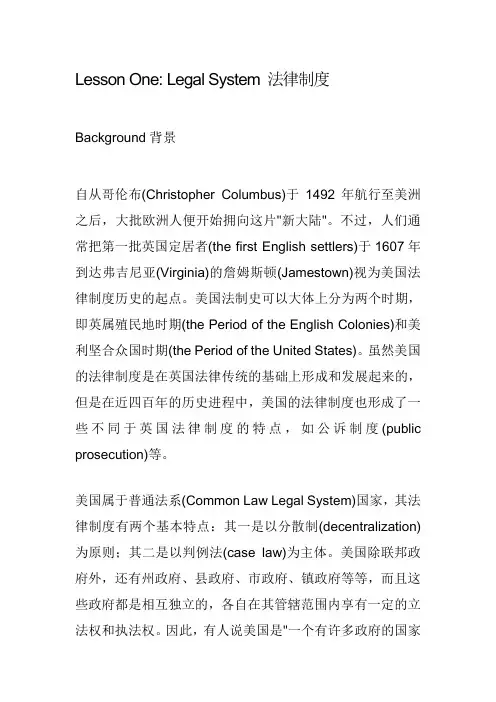
Lesson One: Legal System 法律制度Background背景自从哥伦布(Christopher Columbus)于1492年航行至美洲之后,大批欧洲人便开始拥向这片"新大陆"。
不过,人们通常把第一批英国定居者(the first English settlers)于1607年到达弗吉尼亚(Virginia)的詹姆斯顿(Jamestown)视为美国法律制度历史的起点。
美国法制史可以大体上分为两个时期,即英属殖民地时期(the Period of the English Colonies)和美利坚合众国时期(the Period of the United States)。
虽然美国的法律制度是在英国法律传统的基础上形成和发展起来的,但是在近四百年的历史进程中,美国的法律制度也形成了一些不同于英国法律制度的特点,如公诉制度(public prosecution)等。
美国属于普通法系(Common Law Legal System)国家,其法律制度有两个基本特点:其一是以分散制(decentralization)为原则;其二是以判例法(case law)为主体。
美国除联邦政府外,还有州政府、县政府、市政府、镇政府等等,而且这些政府都是相互独立的,各自在其管辖范围内享有一定的立法权和执法权。
因此,有人说美国是"一个有许多政府的国家"(a country of many governments);而美国的法律体系则是一个"零散的无系统"(fragmental no system)。
诚然,美国现在也有很多成文法(written law)或制定法(statutory law),但是其法律制度仍是以判例法为主体的。
换言之,"遵从前例"(stare decisis)仍然是美国司法活动中最重要的原则之一。
以上两点对于理解美国的法律制度具有重要意义。
![[法学]Lesson 1 Legal System1 2](https://uimg.taocdn.com/b1001fa9a0116c175f0e48fb.webp)
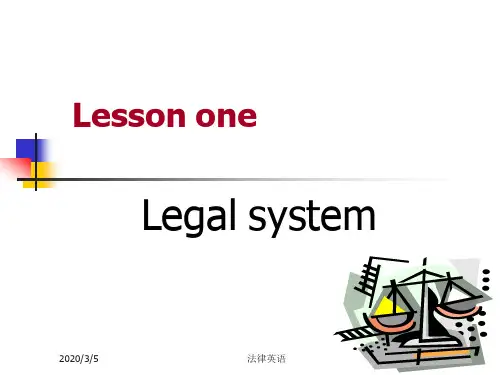

法律英语课文汇总-何家弘————————————————————————————————作者:————————————————————————————————日期:Lesson One: Legal System 法律制度Part OneThe United States is at once a very new nation and a very old nation. It is a new nation compared with many other countries, and it is new, too, in the sense that it is constantly being renewed by the addition of new elements of population and of new States. But in other senses it is old. It is the oldest of the "new" nations--the first one to be made out of an Old World colony. It has the oldest written constitution, the oldest continuous federal system, and the oldest practice of self-government of any nation.One of the most interesting features of Americans youth is that the whole of its history belongs in the period since the invention of the printing press. The whole of its history is, therefore, recorded: indeed, it is safe to say that no other major nation has so comprehensive a record of its history as has the United States, for events such as those that are lost in the legendary past of Italy or France or England are part of the printed record of the United States. And the American record is not only comprehensive; it is immense. It embraces not only the record of the colonial era and of the Nation since 1776, but of the present fifty States as well, and the intricate network of relationships between States and Nation. Thus, to take a very elementary example, the reports of the United States Supreme Court fill some 350 volumes, and the reports of some States are almost equally voluminous: the reader who wants to trace the history of law in America is confronted with over 5,000 stout volumes of legal cases.No one document, no handful of documents, can properly be said to reveal the character of a people or of their government. But when hundreds and thousands of documents strike a consistent note, over more than a hundred years, we have a right to say that is the keynote.When hundreds and thousands of documents address themselves in the same ways, to the same overarching problems, we have a right to read from them certain conclusions which we can call national characteristics.Part TwoThe American legal system, like the English, is methodologically mainly a case law system. Most fields of private law still consist primarily of case law and the extensive and steadily growing statutory law continues to be subject to binding interpretation through case law. Knowledge of the case law method as well as of the technique of working with case law therefore is of central importance for an understanding of American law and legal methodology.The Common Law is historically the common general law -- with supremacy over locallaw--which was decreed by the itinerant judges of the English royal court. The enforcement of a claim presupposed the existence of a special form of action, a writ, with the result that the original common law represented a system of "actions" similar to that of classical Roman law. If a writ existed (in 1227) a claim could be enforced; there was no recourse for a claim without a writ, the claim did not exist. This system became inflexible when the "Provisions of Oxford" (1258) prohibited the creation of new writs, except for the flexibility which the "writ upon the case" allowed and which later led to the development of contract and tort law.The narrow limits of the forms of action and the limited recourse they provided led to the development of equity law and equity case law. "Equity", in its general meaning of doing "equity", deciding ex aequo et bono, was first granted by the King, and later by his Chancellor as "keeper of the King's conscience", to afford relief in hardship cases. In the fifteenth century, however, equity law and equity case law developed into an independent legal system andjudiciary (Court of Chancery) which competed with the ordinary common law courts. Its rules and maxims became fixed and, to a degree, inflexible as in any legal system. Special characteristics of equity law include: relief in the form of specific performance (in contrast to the common law award of compensatory damages), the injunction (a temporary or final order to do or not to do a specific act), the development of so called maxims of equity law which permeated the entire legal system and in many cases explain the origin of modern legal concepts. However, equitable relief regularly will lie only when the common law relief is inadequate. For instance, specific performance for the purchase of real property will be granted because common law damages are deemed to be inadequate since they cannot compensate the buyer in view of the uniqueness attributed to real property.As the common law, equity law became part of American law either through judicial acceptance or through express statutory provision. Today, both legal systems have been merged in many American jurisdictions (beginning with New York in 1848), with the result that there is only one form of civil suit in these jurisdictions as well as in federal practice. Only few States continue to maintain a separate chancery court. Nevertheless, the reference to the historical development is important because, on the one hand, it explains the origin and significance of many contemporary legal concepts (for instance the division of title in the law of property) and, on the other hand, it is still relevant for the decision of such questions whether, for instance, there is a right to a trial by jury (only in the case of common law suits, in other cases only before the judge). In addition, the differentiation will determine whether the "ordinary" common law relief of damages applies or whether the "extraordinary" equity remedy of specific performance is available."Case law" describes the entire body of judge-made law and today includes common law and equity precedents. In imprecise and confusing usage the terms "common law" and "case law"are often used synonymously, with the term "common law" in this usage connotingjudge-made law in general as contrasted with statutory law. "Case law" always connotesjudg-made law, while "common law" in contrast--depending on the meaningintended--describes either the judge made law in common law subject matters or,Lesson Two:Legal Profession 法律职业Part One:The BarThe regulation of the legal profession is primarily the concern of the states, each of which has its own requirements for admission to practice. Most require three years of college and a law degree. Each state administers its own written examination to applicants for its bar. Almost all states, however, make use of the Multistate Bar Exam, a day long multiple choice test, to which the state adds a day long essay examination emphasizing its own law. No apprenticeship is required either before or after admission.A lawyer's practice is usually confined to a single community for, although a lawyer may travel to represent clients, one is only permitted to practice in a state where one has been admitted. However, one who moves to another state can usually be admitted without examination if one has practiced in a state where one has been admitted for some time, often five years.A lawyer may not only practice law, but is permitted to engage in any activity that is open to other citizens. It is not uncommon for the practicing lawyer to serve on boards of directors of corporate clients, to engage in business, and to participate actively in public affairs. A lawyer remains a member of the bar even after becoming a judge, an employee of the government orof a private business concern, or a law teacher, and may return to private practice from these other activities. A relatively small number of lawyers give up practice for responsible executive positions in commerce and industry. The mobility as well as the sense of public responsibility in the profession is evidenced by the career of Harlan Fiske Stone who was, at various times, a successful New York lawyer, a professor and dean of the Columbia School of Law, Attorney General of the United States, and Chief Justice of the United States.There is no formal division among lawyers according to function. The distinction between barristers and solicitors found in England did not take root in the United States, and there is no branch of the profession that has a special or exclusive right to appear in court, nor is there a branch that specializes in the preparation of legal instruments. The American lawyer s domain includes advocacy, counselling, and drafting. Furthermore, within the sphere broadly defined as the "practice of law" the domain is exclusive and is not open to others. In the field of advocacy, the rules are fairly clear: any individual may represent himself or herself in court but, with the exception of a few inferior courts, only a lawyer may represent another in court. Nonlawyers are, however, authorized to represent others in formal proceedings of a judicial nature before some administrative agencies. The lines of demarcation are less clear in the areas of counselling and drafting of legal instruments, as for example between the practice of law and that of accounting in the field of federal income taxation. However, the strict approach of most American courts is indicated by a decision of New York s highest court that a lawyer admitted to practice in a foreign country but not in New York is prohibited from giving legal advice to clients in New York, even though the advice is limited to the law of the foreign country where the lawyer is admitted. A foreign lawyer may, however, be admitted to the bar of one of the states and may, even without being admitted, advise an American lawyer as a consultant on foreign law.Part Two:Lawyers in Private PracticeAmong these fifteen lawyers in practice, nine, a clear majority, are single practitioners. The remaining six practice in law firms, which are generally organized as partnerships. Four or five of these six are partners and the others are associates, a term applied to salaried lawyers employed by a firm or another lawyer. This trend toward group practice is of relatively recent origin. Throughout most of the nineteenth century law practice was general rather than specialized, its chief ingredient was advocacy rather than counselling and drafting, and theprototype of the American lawyer was the single practitioner. Marked specialization began in the latter part of that century in the large cities near the financial centers. With the growth of big business, big government, and big labor, the work of the lawyer accomodated itself to the needs of clients for expert counselling and drafting to prevent as well as to settle disputes. The best lawyers were attracted to this work and leadership of the bar gravitated to persons who rarely if ever appeared in court and who were sought after as advisors, planners, and negotiators. Today the lawyer regards it as sound practice to be continuously familiar with clients business problems and to participate at all steps in the shaping of their policies. Major business transactions are rarely undertaken without advice of counsel.Part Three: House CounselOut of every twenty lawyers, two are employed by private business concerns, such as industrial corporations, insurance companies, and banks, usually as house or corporate counsel in the concern s legal department. The growth of corporations, the complexity of business, and the multitude of problems posed by government regulation make it desirable for such firms to have in their employ persons with legal training who, at the same time, are intimately familiar with the particular problems and conditions of the firm. In large corporations the legal department may number one hundred or more. The general counsel, who heads the office, is usually an officer of the company and may serve on important policy making committees and perhaps even on the board of directors. House counsel remain members of the bar and are entitled to appear in court, though an outside lawyer is often retained for litigation. However, it is the house counsel s skill as advisor rather than as advocate that is a valued asset. Constantly in touch with the employer s problems, house counsel is ideally situated to practice preventive law and may also be called upon to advise the company on its broader obligation to the public and the nation.Part Four:Lawyers in GovernmentA parallel development has taken place in government and two out of twenty lawyers are now employees of the federal, state, county, and municipal governments, exclusive of the judiciary. Many of those entering public service are recent law graduates who find government salaries sufficiently attractive at this stage of their careers and seek the training that such service may offer as a prelude to private practice. Limitations on top salaries, however, discourage some from continuing with the government. The majority serves by appointment in the legal departments of a variety of federal and state agencies and local entities. The United StatesDepartment of Justice alone employs more than two thousands, and the Law Department of the City of New York more than four hundreds. Others are engaged as public prosecutors. Federal prosecutors, the United States attorneys and their assistants, are appointed by the President and are subordinate to the Attorney General of the United States. State prosecutors, sometimes known as district attorneys, are commonly elected by each county and are not under the control of the state attorney general. As a rule, lawyers in government are directly engaged in legal work, since law training is infrequently sought as preparation for general government service. However, a small but important minority that constitutes an exception to this rule consists of those who have been appointed to high executive positions and those who have been elected to political office. Though the participation of lawyers in government has declined recently, for two centuries lawyers have made up roughly half of the Congress of the United States and of the state governors. These figures bear out the comment of Chief Justice Stone that, "No tradition of our profession is more cherished by lawyers than that of its leadership in public affairs."Lesson Three: Legal Education 法律教育In 1983, over 125,000 law students were studying in more than 170 ABA accredited law schools including public law schools supported in part by government funds; private law schools supported by contributions from individuals and foundation funds; and local or national schools offering full time or part time legal study programs. As virtually the only way to prepare for membership in the legal profession, law schools in the United States fulfill several functions including professional training and socialization of future lawyers and screening and gatekeeping for entrance to the profession. Since there is no central institution where all lawyers practice, the only institutional experience which lawyers have in common is law school.The criticisms which range from "mild to caustic" of the way in which law schools have carried out these functions and of the functions themselves have been persistent, diverse and rooted in the historical and political development of the profession. These criticisms have focussed on the curriculum and the dominance of the case method; the distribution of power and prestige reflected in the hierarchy within and among the law schools; and the imbalance in terms of women and minorities in the student body and faculty in the law schools.Part One:Curriculum and the Case MethodThe traditional first-year program offered in virtually all American law schools includes contracts, torts, property, criminal law and civil procedure. Duncan Kennedy has described the traditional first-year curriculum as basically teaching the ground rules for late 19th century laissez-faire capitalism. The second year and third year course expound the moderate reformist New Deal program and the administrative structure of the modern regulatory state. The peripheral subjects, if they are offered, include legal philosophy, legal history, legal process, and clinical education, a "kind of playground or finishing school for learning the social art of self presentation as a lawyer".However, as new areas of the law continue to develop in response to contemporary issues and problems, some law schools have expanded curricula to include courses and clinical programs in environmental law, housing and urban development, women`s rights, health in the workplace, welfare rights and consumer protection. There are also increasing efforts to teach law in interdisciplinary contexts, drawing on other disciplines such as history, psychology, sociology, medicine, and economics.In teaching the traditional curriculum, law teachers in almost all the law schools use to some extent the case method or the Socratic method. Developed in the 1870s by Christopher Columbus Langdell at the Harvard Law School, the case method looked to the common law as the source of legal priniciples and focussed on the teaching of an abstract conception of the law as a science. The legal principles elicited were to be taught divorced from the "grubby world of practice--and also from politics, history, economics, and social contexts". This narrow formalistic approach was justified on the ground that it taught students how to state, analyze, evaluate and compare concrete fact situations thus developing their powers and skills of analysis, reasoning, and expression.However, this process of learning "how to think like a lawyer" has been criticized as having an adverse impact both on the students and the quality of future lawyering. Students, law teachers, and others have pointed to the alienation, anxiety, hostility and aggression caused by use of the case method or Socratic method. The narrow and destructive interaction of this dialogue, or often "no dialogue", contributes to the impairment of the ability to care about otherpeople, a professional unemotionalism and cynicism on the part of law students. And it is not only the law students who suffer from this narrowing of their professional selves. The work of a lawyer involves continuous contacts with clients, associates, other lawyers, judges, witnesses, others affected by the law, and involves the lawyer’s own goals, attitudes, performance, and sense of satisfaction.Part Two:Law School HierarchyDuncan Kennedy has described the law schools as "intensely political places", characterized by a "trade school mentality, the endless attention to trees at the expense of forests." The law schools function as the institution for "ideological training for willing service in the hierarchies of the corporate welfare state". In the ranking and evaluation of students, students learn to accept their place in a hierarchy which is presented as just and inevitable and "so prepare themselves for all the hierarchies to follow". In the law teachers modeling of hierarchical relationships with students, colleagues, secretaries and support staff, students learn a particular style of condescension towards perceived inferiors and deference towards perceived superiors. And under the subtle but intense pressure to conform to the "white, male, middle class tone" set by law faculties which are overwhelmingly white, male, and middle class, law students adapt, "partly out of fear, partly out of hope of gain, partly out of genuine admiration for their role models". In these ways, "legal education is one of the causes of legal hierarchy. Legal education supports it by analogy, provides it a general legitimating ideology by justifying the rules that underlie it, and provides it a particular ideology by mystifying legal reasoning. Legal education structures the pool of prospective lawyers so that their hierarchical organization seems inevitable, and trains them to look and think and act just like all the other lawyers in the system" .In addition to the hierarchy within the law schools suggested by Kennedy, other analyses of the law schools functions and relationship to the profession suggest the existence of a hierarchy among the law schools. The top dozen or so elite law schools occupy a position of power and prestige which is partially reflected in the professional career paths of their graduates and in the "old boy networks" connecting the law schools and the rest of the legal profession. The models of the "law school as the gateway to the American power elite became possible with the New Deal". Felix Frankfurter’s placement n etwork for the "best and the brightest" into influential public policy positions during the New Deal in the 1930s was anearly example of this kind of network. During his tenure at Harvard and later while on the Supreme Court, Frankfurter developed an "old boy network" which was intimately involved with the placement of many of the "elite" lawyers, all of whom were white and male, into public service. The typical Frankfurter recruit was "a graduate of Harvard Law School, politically liberal, usually ranked high in his class, and either an obvious product of upper class gentile culture or an obvious product of a radically different culture who was 'comfortable' in the upper class gentile world".In the current hiring practices of the major law firms and in the competition for judicial clerkships, and in the appointments to law faculties, the graduates of the elite schools continue to have an advantage over graduates of other schools. In a recent study of Chicago lawyers, Zemans and Rosenblum found that lawyers who attended "high-prestige law schools and graduated in the top 20 percent of their classes were much more likely to practice in large firms and specialize in high-prestige fields of law". In terms of appointments to law faculties, 60% of the legal prof ession’s teaching specialists are produced by fewer than 15% of the nation s accredited law schools. These law teacher producer schools are mostly national, located in urban locations, and include schools such as Harvard, Yale, Columbia, University of Michigan, Chicago, New York University, Northwestern University, and Georgetown. If it is true that the full time faculty of the law schools "have a virtual monopoly on who will and will not enter the (legal) profession" and "on the power to mold future generations", then the existence of a hierarchy among the law schools suggests that an elite group of schools is primarily responsible for staffing the law schools, which in turn produce lawyers for the hierarchies within the profession.Lesson Four:Judicial System 司法系统Part One:CourtsThere are fifty-two separate court systems in the United States. Each state, as well as the District of Columbia, has its own fully developed, independent system of courts and there is a separate federal court system. The federal courts are not superior to the state courts; they are an independent, coordinate system authorized by the United States Constitution, Art. Ⅲ,§2, to handle matters of particular federal interest. The presence of two parallel court systems often raises questions concerning the relationship of the state and federal systems, presentingimportant issues of federalism. The United States Supreme Court, composed of nine justices, sits as the final and controlling voice over all these systems.Although a few states, such as Nebraska, have a two-tiered system, most states, as well as the federal courts, are based on a three-tiered model. That means that for any litigant there will be the opportunity to plead his case before a trial court and then, should he lose, there are two levels of appeal at which he ultimately may succeed. For example, in the federal system the trial court is the United States District Court, of which there is at least one in every state. Many larger states are divided into two, three or even four judicial districts, depending on population, geography and caseload. There are ninety-four districts in the United States and each district court has one judge, or more commonly two or more. After an adverse judgment in the district court, a litigant may appeal to the United States Court of Appeals for the circuit in which the district court is located. There are eleven numbered intermediate appellate courts in the federal system, each including anywhere from three to ten states and territories. Additionally, there is a Court of Appeals for the District of Columbia, hearing appeals from the federal district court there, and one for the Federal Circuit, taking appeals from various specialized federal tribunals, such as the Claims Court. Each court of appeals has four or more judges who sit in panels of three to review district court decisions, as well as some decisions of administrative agencies. A losing litigant in the court of appeals may, in some cases, be able to obtain review by the United States Supreme Court. Cases in the state courts similarly may proceed through a trial court, a state appellate court, and then the state supreme court. If a federal constitutional question is involved the decision of the state Supreme Court may be reviewed by the United States Supreme Court. Since 1988, review by the Supreme Court in civil cases is discretionary; virtually all civil appeals as of right to the highest court have been abolished.Three-tiered systems vary on the role which the highest court plays. The approaches taken reflect differing philosophies with regard to what the highest court should do. For example, in California only criminal cases in which capital punishment has been imposed are appealable as of right to the state supreme court. Similarly, in the federal courts, except in a few very limited circumstances, appeals to the United States Supreme Court are discretionary, by writ of certiorari. The Court decides for itself what are the most important questions that deserve its attention and will refuse to review decisions raising issues that it feels are not as crucial. In this way it supervises the administration of law by the lower courts on an ad hoc basis. At the other end of the spectrum, such as in New York, appeals to the state s highest court are as of rightin a great many cases provided for by statute. The primary function of the highest court in New York appears to be to assure that cases are correctly decided. It is necessary to check carefully the statutes of the system in which you are appearing to determine the specific rules regarding review by those appellate courts.Part Two:JudgesFewer than one in twenty of those admitted to practice law is a federal, state, county, or municipal court judge. Except for some inferior courts, judges are generally required to be admitted to practice but do not practice while on the bench. There is so little uniformity that it is difficult to generalize further than to point out three salient characteristics that relate to the ranks from which judges are drawn, to the method of their selection, and to their tenure.Judges are drawn from the practicing bar and less frequently from government service or the teaching profession. There is in the United States no career judiciary like that found in many other countries and there is no prescribed route for the young law graduate who aspires to be a judge, no apprenticeship that must be served, no service that must be entered. The outstanding young law graduates who act for a year or two as law clerks to the most distinguished judges of the federal and state courts have only the reward of the experience to take with them into practice and not the promise of a judicial career. While it is not uncommon for a vacancy on a higher court to be filled by a judge from a lower court, even this cannot be said to be the rule. The legal profession is not entirely unaware of the advantages of a career judiciary, but it is generally thought that they are outweighed by the experience and independence which American lawyers bring to the bench. Many of the outstanding judges of the country s highest courts have had no prior judicial experience. Criticism has centered instead on the prevalent method of selection of judges.State court judges are usually elected, commonly by popular vote, but occassionally by the legislature. Popular election has been the subject of much disapproval, including that of the American Bar Association, on the ground that the public lacks interest in and information on candidates for judicial office and that therefore the outcome is too often controlled by leaders of political parties. The situation has been somewhat improved since many local bar associations have undertaken to evaluate the qualifications of candidates and to support or oppose them on this basis.。
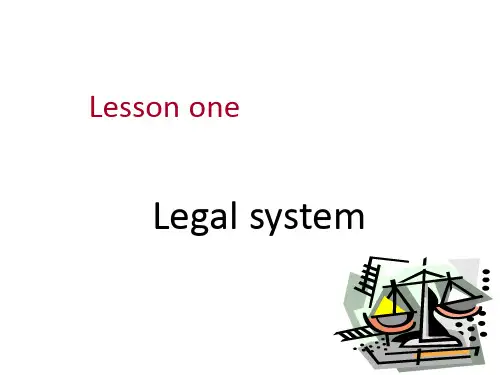
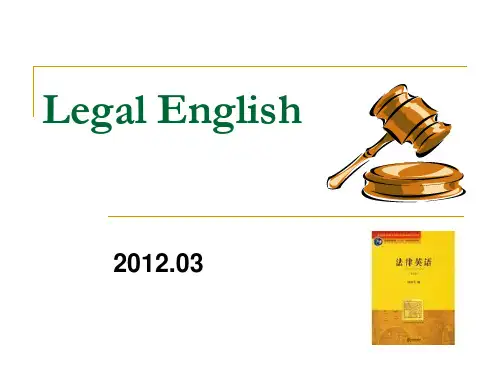
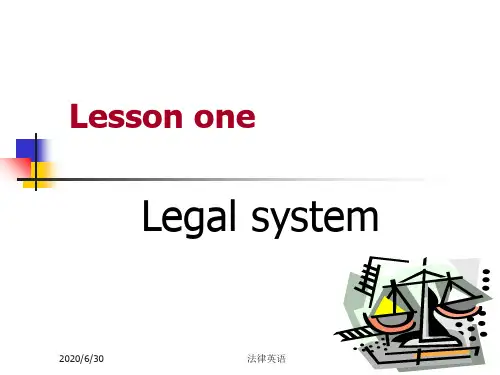
教案首页章节名称Introduction to Legal EnglishLegal system教学目的通过讲授,让学生简单了解法律英语的意义,学习目的以及通过讲授让学生了解到法律英语对于法学专业的学生的真正意义。
介绍法律的基本制度。
教学内容Part one features systemsPart two common law and equity law教学重点与难点重点:法律制度的基本内容难点:普通法系和大陆法系授课方法多媒体授课,案例教学,启发式教学教学时数4课时教学过程备注Introduction to Legal English1、Fundamental Requirements(1)To learn legal terms(2)To learn how to read cases(3) To learn how to express opinions or ideas(4 ) To know the way to learn Legal English, including how to make use of the law dictionaries, the internet resource and reference booklegal terms:constitutiontort lawcommon lawequity Lawreal propertypersonal propertytrial by juryAmerican ConstitutionLearning Methods1.坚持看原版的法律新闻,最好的地方如下,如果上网方便,最好每天去一次,哪怕是时间只够把新闻标题看完2.坚持用原版的法律词典,最好的当然是black’s law dictionary,不过,这两个地方的法律词典也不错。
当然,刚开始用原版的法律词典可能有些不习惯,从长远来看,这是非常有好处的。
1.课程负责人及任课教师简介姓名性别出生年月专业职务研究专长学历学位工作单位谭宗燕女1976年7月讲师外国语言学及应用语言学研究生硕士武昌理工学院文法与外语学院英语系2.课程说明与介绍一、课程说明课程名称: 法律英语学分: 2学分学时: 36学时选课对象: 法学修读要求:大学英语课程、法律基础类课程考核方式:平时成绩占40%,期末占60%。
期末考试。
使用教材:《法律英语——美国法律制度》(第四版),法律出版社。
二、课程的性质和任务《法律英语》是依据《大学英语教学大纲》对大学英语应用提高阶段在专业英语方面的教学要求,适应中国加入世贸组织后进一步扩大对外交流形式的需要,以培养更多既有扎实法律专业知识又精通外语的复合型人才的需求,所开设的英语专业本科选修课程。
本课程以英美法为教学核心内容,包括英语法律术语、英美法系与大陆法系的比较、英美律师职业介绍、英美主要部门法、WTO 法律文件选读、国际经贸法律、法学研究技巧与资源的运用。
三、教学对象的要求本课程历时一个学期,其教学目的旨在培养和提高学生在法律领域里应用英语的能力。
在教师的指导下,学生通过阅读一些精选的法律类英语文章掌握法学基本概念和基本理论以及专业术语。
在教学过程中着重于扩大学生的专业词汇量,提高学生的英语阅读理解水平。
同时,本课程采用个人发言和小组讨论等多种形式以增加学生的语言实践机会,使他们能将专业知识与英语知识很好地结合,最终具有较强的英语口头交流能力和翻译能力。
四、本课程的教学重点、难点、创新点:教学重点:1.掌握每课中的法律专业术语;2.了解美国法律制度的内容以及与中国的不同,特别是在宪法、法院体系、司法审查、法学教育与法律职业方面所表现出来的异同;3.掌握一些必要的法律英语句法特征和翻译技巧,提高阅读和翻译能力。
教学难点:1.法律英语长句、难句的翻译和理解;2.英语听说译能力的培养与提高。
创新点:在课程教学的过程中,教师应针对以上提到的难点,有的放矢的组织教学。
课后复习资料Topic 1 Legal SystemThe objective of the lesson is to introduce the major legal systems in the world.1. civil law and common law2. sources of American law3. Common law and equity law重点:the characteristics of common law, the difference between civil law and common law,the difference between common law and equity law. doctrine of stare decisis考核要求:Students are required to use the legal terms and make comparisons among the legal system.复习思考题:1. What is the difference between civil law and common law?2. What are the special characteristics of equity law?3. what are the functions of stare decisis?4. How do the judges make a decision on a case of first impression?5. Is China a civil law country or common law country?why?Word listcodify v.使法典化,法典编纂democracy n.民主precedent n.先例delegation n.授权promulgate v.公布、颁布tribunal n.法庭executive a.行政的statutory a.成文法的,法定的jury n.陪审团trial n.审判injunction n.强制令legal system 法律制度或者法律体系、法系civil law 民法common law 普通法stare decisis 遵循先例Court of Chancellor 衡平法院Compensatory damages 补偿性赔偿金。
《法律专业外语》课程教学大纲一、《法律专业外语》课程说明(一)课程代码:02130016(二)课程英文名称:Legal English(三)开课对象:法学专业(四)课程性质:本课程是法学专业必选学科选修课程之一,一般在大学三年级开设。
法学专业本科学生通过两年的大学英语的学习,已掌握了普通英语的基本语汇、语汇和句型,为法律专业英语的学习打下了良好的基础。
法律专业英语课程的开设一方面为学生继续学习英语提供了良好的机会,另一方面也能使学生运用英语来表达自己所学的法律专业知识,从而为他们将来直接运用英语获得本专业的最新信息奠定基础。
其前导课程有综合英语、基本法律课程等。
在课程类别中属于专业教育课程、专业必修课。
(五)教学目的:通过这门课的教学与学习,将使学生了解和掌握法律英语的阅读与写作方法,并从众多节选于国外名著名篇中的课文里,了解国外尤其是英美法系国家里的法律制度,并培养学生运用已学的英语知识和相关法律原理来分析、处理和解决实际案例的能力。
(六)教学内容:本课程要求学生,首先必须熟知相关的法律知识,即英美法律制度,然后通过教师对某些课文的讲解和学生自身根据教师提问对某些课文的阅读,掌握相关法律词汇,包括法律英语中基本词汇,以及学生已熟悉,但在法律语境下,与日常用义大相径庭的词汇;掌握法律英语中长句的理解和翻译,从而熟悉和掌握法律英语的特点。
(七)学时数、学分数及学时数具体分配学时数: 48学时分数: 3学分(八)教学方式教学方式以课堂教学为主。
(九)考核方式和成绩记载说明考核方式为考查。
严格考核学生出勤情况,达到学籍管理规定的旷课量取消考试资格。
综合成绩根据平时成绩和期末成绩评定,平时成绩占40% ,期末成绩占60% 。
二、讲授大纲与各章的基本要求Lesson One:Legal System法律制度教学要点:Pre-reading tasks1.What legal systems do you know about? Can you say something about them?2.What is Russia’s legal system? And The Scandinavian countries’?Comprehension of the text: Answer the following questions1.How did civil-law system come into being?2.What countries does the civil-law family have influence on?3.What counties does the common law system have influence on?4.What is the characteristic of the civil-law family?5.What is the doctrine of common law?6.Does the development of a country have a close relationship with the country’s law?What is the difference between the civil-law family and the common law system?教学时数:2 学时教学内容:Legal systemsClusters/families/groups of legal systemsCivil-law familyCommon law systemlaw schools accredited by the American Bar Association. Most states do not accept bar applications from graduates of law schools not on that list.In the first year of law school students generally are required to take broad introductory topics. These may include torts, contracts, criminal law, civil procedure, property, and constitutional law. Many schools also require courses in legal writing and legal research.The second and third years of law school allow a student to concentrate on particular areas of the law such as business, litigation, international, or family law. A number of courses may still be recommend or required such as federal income taxation, corporations, commercial law, and professional ethics. In addition, the second and third years often provide the student with the chance to get some legal experience through legal aid clinics and internships.Law students usually participate in extra-curricular activities that provide them with further useful experience. Law reviews are legal academic journals edited and in part written by students. Membership in law review is usually granted on the basis of first year grades or a writing competition. Moot Court provides students with the opportunity to compete with one another by giving mock oral arguments before a panel of judges.Law school teaching tends to be far more interactive than is common in undergraduate education, despite large classes. In the classic "Socratic Method" the law professor asks a student a series of questions about assigned cases.教学时数:2 学时教学内容:Part one: Curriculum and the case methodPart two: Law school hierarchy考核要求:Which teaching method is better forlaw study:case method or lecture method?Lesson Four:Judicial System司法系统教学要点:1st period pre-reading activities (familiar with new words, terms, and background information)2nd period while reading (highlights of the text)3th period after-reading activities教学时数:2 学时教学内容:Part one:Courts--the Supreme Court--Court of Appeals--District CourtPart two:Judges--Justice--Judge--Justice of Peace/Magistrate考核要求:1.How many court systems are there in the United States? And what are they?2.How many judges generally are there in a federal district court?3.How are state court judges usually selected?Lesson Five:Constitution宪法教学要点:Warming-up questions1. How much do you know about English constitution?2. Can you guess what the theme of this unit refers to?3. Can you say something about the organ of the English government?Comprehension of the text.1. What is the form of government based on in Britain?2. According to the text, which of the following does not hold power?3. Which of the following causes a new election of the Cabinet?4. Where are the policies of the government warmly discussed and closely watched?5. How often is the election for seats in Commons held?教学时数: 2 学时教学内容:ConstitutionUnwritten constitutionSovereignMonarchExecutive branchCabinetHouse of CommonsHouse of Lords考核要求:Students will be able to:1.understand the main idea (the function of each organ of the government and their relationship in England)of the text;2. master some related legal terms; understand how the government work3. conduct a series of reading, listening, speaking and writing activities related to the theme of the unit.Lesson Six:Administrative Law行政法教学要点:Administrative law encompasses laws and legal principles governing the administration and regulation of government agencies (both Federal and state).Generally, administrative agencies are created to protect a public interest rather than to vindicate private rights.教学时数:2 学时教学内容:Administrative lawAgency actionAdministrative unitAdjudicationRulemakingdiscretionary考核要求:1.What is the scope of administrative law?2.What is agency action?3.What is interpretation in administrative law?4.What are the central tasks of administrative law?Lesson Seven:Criminal Law刑法教学要点:Students will be able to:1. understand the main idea (the general knowledge of crimes and punishment) of thetext;2. master some related legal terms;3. conduct a series of reading, listening, speaking and writing activitiesrelated to the theme of the unit.4. try to understand the criminal procedure教学时数:4 学时教学内容:Justice1. the ideal of fair and beneficent treatment of all people by each other and by their governments, which law in a democratic society attempts to serve2. the system of law and administration of lawCriminal justiceJustice of the peaceFraudStatuteCodeSelf-defenseMisdemeanor--a crime less serious than a felony, usually one punishable by incarceration for up to one year, in some states misdemeanors include some offenses punishable only by a fine考核要求:1. Comprehension of the text.1) Which aspect of law are ordinary people most familiar with?2) What kind of criminal conduct can be found in a federal government code?3) In which country was it illegal to own gold in the past?2. VocabularyCompare and contrast the following pair of wordscrime/criminal vary/variable threat/threaten violate/violationburglar/burglary3. GrammarLesson Eight:Civil Rights Law民权法教学要点:A civil right is an enforceable right or privilege, which if interfered with by another gives rise to an action for injury. Examples of civil rights are freedom of speech, press, assembly, the right to vote, freedom from involuntary servitude, and the right to equality in public places. Discrimination occurs when the civil rights of an individual are denied or interfered with because of their membership in a particular group or class. Statutes have been enacted to prevent discrimination based on a persons race, sex, religion, age, previous condition of servitude, physical limitation, national origin and in some instances sexual preference.教学时数:2 学时教学内容:The most important expansion of civil rights in the United States was the enactment of the Thirteenth and Fourteenth Amendments.The most prominent civil rights legislation since reconstruction is the Civil Rights Act of 1964.The judiciary, most notably the Supreme Court, plays a crucial role in interpreting the extent of the civil rights.The existence of civil rights and liberties are recognized internationally by numerous agreements and declarations.International Covenant on Civil and Political Rights.考核要求:1.What is the common form of racial discrimination in the workplace?2.What is the Walker v. IRS about?Lesson Nine:Contract Law合同法教学要点:Students will be able to:1. understand what makes a valid contract;2. master some related legal terms;3. conduct a series of reading, listening, speaking and writing activities related to the themeof the unit.教学时数:4 学时教学内容:In legal terms, a contract is:1.A promise (or set of promises) that the law protects and enforces. e.g.2.seller: promise to deliver a carload of lumber3.buyer: promises to pay the seller a certain price4.If one party breached the contract, the other party can choose to sue.A valid contract“offer” and “acceptance” are promises and must be supported by “consideration”,which is: --a mysterious substance,--an intricate legal concept--underlying idea: each party makes his promise “in consideration” of something the other party promises.--e.g. I offer to sell my old car for $2,000, the buyer accepts (promising to pay $2,000) --- consideration on each side is clear.--e.g. I promise to give my daughter a handful of diamonds --- there is no “consideration” for my promise.考核要求:Pre-reading tasks1.What is a contract?2.What can people do with contracts?After-reading activitiesComprehension of the text: Answer the following questions1.How to understand “from status to contract”?2.What is a contract in legal terms?3.What are the factors in a valid contract?4.What is consideration?5.Why do businessmen tend to sidestep contract law in the world of affairs?6.What is the relationship between contract law and commercial law?Lesson Ten:Tort Law侵权法教学要点:Students will be able to:1.understand the main idea (the knowledge of tort law)of the text;2.master some related legal terms;3. conduct a series of reading, listening, speaking and writing activitiesrelated to the theme of the unit.教学时数: 2 学时教学内容:TortTortfeasorWrongFellow servant rule/doctrineNegligenceRecoverReasonable man/personStrict liability考核要求:Pre-reading tasks1. How much do you know about Torts law?2. What can be covered in torts law?After-reading activitiesComprehension of the text.1.What is the common characteristic of the behaviors defined as civil wrongs?2. Which category of civil wrongs has not grown rapidly in the 20th century?3. As for the product liability, to whom the court judgments are favorable in the 20th century?4. According to the text, what is the fundamental concept of tort law?Lesson Eleven:Property Law财产法教学要点:Property signifies dominion or right of use, control, and disposition which one may lawfully exercise over things, objects, or land. One of the basic dividing lines between property is that between real property and personal property. Generally, the term real property refers to land. Land, in its general usage, includes not only the face of the earth but everything of a permanent nature over or under it. This includes structures and minerals.教学时数:2 学时教学内容:There are further divisions within the real property classification. The most important are freehold estates, nonfreehold estates, and concurrent estates. (Others are future interests, specialty estates, and incorporeal interests).---Freehold estates are those in which an individual has ownership for an indefinite period of time. An example of a freehold estate is the "fee simple absolute", which is inheritable and lasts as long as the individual and his heirs wants to keep it. Another example is the "life estate", in which the individual retains possession of the land for the duration of his or her life.---Nonfreehold estates are property interests of limited duration. They include tenancy for years, tenancy at will, and tenancy at sufferance.---Concurrent estates exist when property is owned or possessed by two or more individuals simultaneously考核要求:1.What are the roles of government in the field of property law?2.What are the lawyers in the field of property law?3.What are the major areas in real property law?Lesson Twelve:Corporation Law公司法教学要点:A corporation is a legal entity created through the laws of its state of incorporation. Individual states have the power to promulgate laws relating to the creation, organization and dissolution of corporations. The law treats a corporation as a legal "person" that has standing to sue and be sued, distinct from its stockholders. The legal independence of a corporation prevents shareholders from being personally liable for corporate debts. It also allows stockholders to sue the corporation through a derivative suit and makes ownership in the company (shares) easily transferable. The legal "person" status of corporations gives the business perpetual life; deaths of officials or stockholders do not alter the corporation's structure.教学时数:2 学时教学内容:Corporation LawPart one: IntroductionPart two: Forms of businessA.ProprietorshipsB.PartnershipsC.Corporations考核要求:1.What are the main classes of business enterprises in the United States?2.What are the main categories of laws applicable to business enterprises in the United States?3.What are Blue Sky Laws?Lesson Thirteen:Insurance Law保险法教学要点:In the absence of insurance, three possible individuals bear the burden of an economic loss; the individual suffering the loss; the individual causing the loss via negligence or unlawful conduct; or lastly, a particular party who has been allocated the burden by the legislature, such as employers under Workmen's Compensation statutes. While types of insurance vary widely, their primary goal is to allocate the risks of a loss from the individual to a great number of people.教学时数:2 学时教学内容:In general, insurance companies are the safekeepers of the premiums. Because of its importance in maintaining economic stability, the government and the courts use a heavy hand in ensuring these companies are regulated and fair to the consumer.Each individual pays a "premium" into a pool, from which losses are paid out. Regardless of whether the particular individual suffers the loss or not the premium is not returnable.Up until 1944, insurance was not considered "commerce" and not subject to federal regulation. But in United States v. South-Eastern Underwriters Association, the Supreme Court held that Congress could regulate insurance transactions that were truly interstate.考核要求:1.Why do people purchase group insurance for personal needs?2.What are the important of insurance for business?3.What is “key man ” insurance?Lesson Fourteen:Commercial Law商法教学要点:Commercial law governs the broad areas of business, commerce, and consumer transactions. Specific law has developed in a number of commercial fields. The Uniform Commercial Code, which has been substantially adopted as statutory law in nearly every state, governs numerous areas of commercial law.教学时数:2 学时教学内容:Banks and bank accounts are regulated by both state and federal statutory law. Bank accounts may be established by national and state chartered banks and savings associations. All are regulated by the law under which they were established.Bankruptcy law provides for the development of a plan that allows a debtor, who is unable to pay his creditors, to resolve his debts through the division of his assets among his creditors.Credit allows consumers to finance transactions without having to pay the full cost of the merchandise at the time of the transaction.Negotiable instruments are mainly governed by state statutory law.Real estate transactions are governed by a wide body of federal statutes and state statutory and common law.考核要求:1.What is the history of the commerce clause adjudication?2.What does the Supreme Court interpret the commerce clause?Lesson Fifteen:Tax Law税法教学要点:The focus of this lesson is on tax and related issues. Tax includes income(corporate and personal), excise and other taxation devices. Commercial law, trade,intellectual property, etc. deal with the transactions giving rise to tax. Businessorganizations focuses upon the entities themselves.教学时数: 2 学时教学内容:Part one:Federal taxation1.Introduction2.Generalscope of the taxing power3.Direct v. indirect taxes4.Federal taxing and due process5.Federal taxes as regulatory measuresPart two:State taxation1.Death taxes2.Income taxes考核要求:1.What are the two limitations upon the exercise of Congress’ taxation power?2.What are the principles of due process with respect to jurisdiction to impose income taxesupon individuals and corporations in the United States?Lesson Sixteen:Environmental Law环境保护法教学要点:The National Environmental Policy Act (NEPA) was passed in 1970 along with the Environmental Quality Improvement Act, the Environmental Education Act, and the Environmental Protection Agency (EPA). The main objective of these federal enactments was to assure that the environment be protected against both public and private actions that failed to take account of costs or harms inflicted on the eco-system.The EPA was supposed to monitor and analyze the environment, conduct research, and work closely with state and local governments to devise pollution control policies. NEPA (really enacted in 1969) has been described as one of Congress's most far reaching environmental legislation ever passed. The basic purpose of NEPA is to force governmental agencies to consider the effects on the environment of their decisions.State laws also reflect the same concerns and common law actions in nuisance allow adversely affected property owners to seek a judicial remedy for environtal harms harms.教学时数:2 学时教学内容:Part one: National environmental policy act(Enacted in 1970;Amended in 1975)Title one DECLARATION OF NATIONAL ENVIRONMENTAL POLICY Part two :Federal actions to address environmental justice in minority populations and low-income populations(Executive order 12898,1994)考核要求:1.Why did the Congress make the Declaration of National Environmental Policy?2.What is the continuing policy of the Federal Government?3.What are main contents of an environmental impact statement?Lesson Seventeen:Family Law家庭法教学要点:The right to freedom of choice in marriage and family relationships lies at the heart of the right to privacy. Family relationships, by their nature involve deep attachments and commitments to the necessarily few other individuals with whom one shares not only a special community of thoughts, experiences, and beliefs but also distinctly personal aspects of one’s life.教学时数: 2 学时教学内容:Domestic relations law--Marriage-husband-wife relation--divorce--separation--parent-child relation--adoption--custody--support考核要求:1.Should Abortion Be Legal?2.What is the relationship between the right to privacy and the right to freedom ofchoice in marriage and family relationships?Lesson Eighteen:Intellectual Property Law知识产权法教学要点:Pre-reading tasks1.What is copyright?2.What rights does Copyright Law protect?3.How can an owner get protected by Copyright Law?Comprehension of the text: Answer the following questions1.What rights does Copyright Law protect?2.What is a prescribed copyright notice made up of?3.How can an owner get protected by Copyright Law?4.What remedies may a copyright owner have if infringement is proved?5.As to the exception to the copyright infringement, what activities are in the realm of fairuse?6.What has been done to protect the copyright owners in the world?教学时数:2 学时教学内容:CopyrightCopyright can be sold or licensed to othersFormalities requirement under U.S. lawUCC (the Universal Copyright Convention)To secure copyright protection in the USA and UCC member nationsOther international conventions考核要求:Students will be able to:1. understand what makes a valid contract;2. master some related legal terms;3. conduct a series of reading, listening, speaking and writing activities related to the themeof the unit.Lesson Nineteen:Civil Procedure民事诉讼程序教学要点:Broadly speaking, civil procedure consists of the rules by which courts conduct civil trials. "Civil trials" concern the judicial resolution of claims by one individual or group against another and is to be distinguished from "criminal trials", in which the state prosecutes an individual for violation of criminal law."Procedure" is to be distinguished from "substantive law" in that substantive law defines the rights and duties of everyday conduct. Substantive law includes contract law, tort law, and so on.In America, civil procedure usually takes the form of a series of rules and judicial practices. The federal courts follow the Federal Rules of Civil Procedure; the state courts follow their own state rules of civil procedure.In federal courts, evidentiary rules are governed by the Federal Rules of Evidence.The state courts follow their own state rules of evidence.教学时数: 2 学时教学内容:adersary systemjury systemFederal Rule of Civil ProcedureJury Trial1.In general2.Scope of jury rights3.Means of controlling the jury考核要求:1.What were the there types of courts in the English legal history?2.What are the distinctive characteristics of the adversary trial system?3.Writing a legal memorandumLesson Twenty:Criminal Procedure刑事诉讼程序教学要点:The rules of criminal procedure are different from those of civil procedure, because the two areas (criminal and civil) have different objectives and results. In criminal cases, the state brings the suit and must show guilt beyond a reasonable doubt, while in civil cases the plaintiff brings the suit and must only show the defendant is liable by a preponderance of the evidence.The American criminal system is an adversarial and accusatorial model. Criminal procedure must balance the defendant's rights and the state's interests in a speedy and efficient trial with the desire for justice. Therefore, the rules of criminal procedure are designed to ensure that a defendant's rights are protected.教学时数: 2 学时教学内容:Part one : the adversary systemPart two: the accusatorial systemThe burden of proofThe burden of going forward with the evidencePresumption of innocencePart three: standards of proof考核要求:1.How does an adversary system arrive at a decision?2.What is an inquisitorial system?3.How many standards of proof are critical legal standards and what are they?4.What is the key to an accusatorial process of proof?Lesson Twenty One:Rules of Evidence证据规则教学要点:There are two principal questions about evidence that have to be answered.First, what matters and what materials should be admitted into evidence for the jury to consider?Secondly, what use can properly be made by the jurors of those matters and materials that are ruled admissible?教学时数: 2 学时教学内容:Rules of evidence: Admissibility; Relevancy;Weight;Sufficiency;Burden of proofTypes of evidence : direct evidence; indirect evidenceForms of evidence--Testimonial evidence--Tangible evidence--Judicial notice考核要求:1.What do the rules of evidence apply to?2.What is ‘RELEV ANT EVIDENCE”?3.What evidence is not admissible?4.What are the court direct a party to predicate error upon a ruling?Lesson Twenty Two:WTO Rules世贸组织规则教学要点:The WTO’s procedure for resolving trade quarrels under the Dispute Settlement Understanding is vital for enforcing the rules and therefore for ensuring that trade flows smoothly.A dispute arises when a member government believes another member government is violating an agreement or a commitment that it has made in the WTO. The authors of these agreements are the member governments themselves —the agreements are the outcome of negotiations among members. Ultimate responsibility for settling disputes also lies with member governments, through the Dispute Settlement Body.教学时数: 2 学时教学内容:A unique contributionDispute settlement is the central pillar of the multilateral trading system, and the WTO’s unique contribution to the stability of the global economy. Without a means of settling disputes, the rules-based system would be less effective because the rules could not be enforced. The WTO’s procedure underscores the rule of law, and it makes the trading system more secure and predictable. The system is based on clearly-defined rules, with timetables for completing a case. First rulings are made by a panel and endorsed (or rejected) by the WTO’s full membership. Appeals based on points of law are possible.---Principles: equitable, fast, effective, mutually acceptable---First stage: consultation (up to 60 days).--- Second stage: the panel (up to 45 days for a panel to be appointed, plus 6 months for the panel to conclude).---Appeals考核要求:1.How are disputes settled?2.What is DSU?3.What is DSB?三、推荐教材和参考书目1.《法律英语》,何家弘,第二版,法律出版社,20042.《法律英语教程》,沙丽金、林萍,中国政法大学出版社,20003.《法律英语》,董世忠、赵建,复旦大学出版社,19974.《法律英语核心教程》,杜金榜、张新红,对外经济贸易大学出版社,2002执笔人:申静审核人:张道功审定:法学院。
Lesson One: Legal System 法律制度Background背景自从哥伦布(Christopher Columbus)于1492年航行至美洲之后,大批欧洲人便开始拥向这片"新大陆"。
不过,人们通常把第一批英国定居者(the first English settlers)于1607年到达弗吉尼亚(Virginia)的詹姆斯顿(Jamestown)视为美国法律制度历史的起点。
美国法制史可以大体上分为两个时期,即英属殖民地时期(the Period of the English Colonies)和美利坚合众国时期(the Period of the United States)。
虽然美国的法律制度是在英国法律传统的基础上形成和发展起来的,但是在近四百年的历史进程中,美国的法律制度也形成了一些不同于英国法律制度的特点,如公诉制度(public prosecution)等。
美国属于普通法系(Common Law Legal System)国家,其法律制度有两个基本特点:其一是以分散制(decentralization)为原则;其二是以判例法(case law)为主体。
美国除联邦政府外,还有州政府、县政府、市政府、镇政府等等,而且这些政府都是相互独立的,各自在其管辖范围内享有一定的立法权和执法权。
因此,有人说美国是"一个有许多政府的国家"(a country of many governments);而美国的法律体系则是一个"零散的无系统"(fragmental nosystem)。
诚然,美国现在也有很多成文法(written law)或制定法(statutory law),但是其法律制度仍是以判例法为主体的。
换言之,"遵从前例"(stare decisis)仍然是美国司法活动中最重要的原则之一。
以上两点对于理解美国的法律制度具有重要意义。